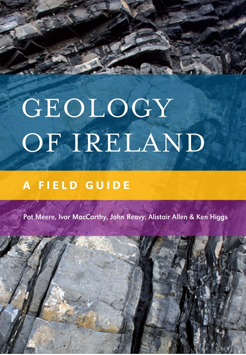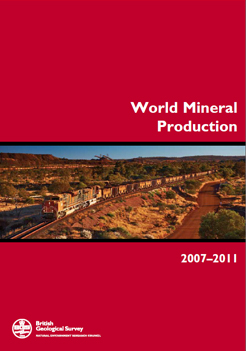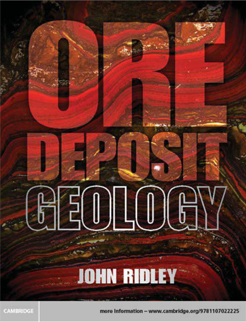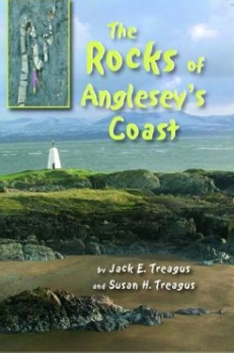 Geology of Ireland: a field guide
Geology of Ireland: a field guide
One of the big issues in geology is that of scale, and in particular how the details of the information available in hand specimen and outcrop are linked to larger scale models for the evolution of geological terrains or the continental crust. There are also increasing pressures on training field geology, and so this guide is both timely and welcome. It provides a practical and accessible introduction to the geology of Ireland distilled from many decades of student and conference field trips around the country.
The guide is in two parts, one on the broad principles of geology, with the main part as the field guide to 17 areas, mostly around the coast. The areas selected range from the oldest basement rocks in NW Mayo through a number of sedimentary localities and key igneous outcrops, and in some cases the overlying Quaternary is included in the descriptions. The geology of Ireland remains a rich heritage spanning over two billion years, and at least in the coastal and more mountainous areas, it is well exposed.
There are tantalising claims that a number of key concepts in geology were originally developed and tested in Ireland, without the space to provide the supporting evidence! Juxtaposing a brief introduction to the principles of geology and the details of the field geology in the different areas also highlights a series of questions around how the specific evidence from outcrop informs larger scale regional models. The geological record is far from complete and in many ways it offers a biased and perhaps not very representative record. How we infer the nature of natural processes from the rock record, and what aspects are best developed and tested in the field, remain at the core of these discussions.
Each of the 17 field trips described includes a summary of the local geology, a list of background reading and an estimate of the duration and the likely conditions underfoot. They are clearly laid out with good quality colour photographs and clear summaries of the outcrops and suggested interpretations. The rocks range from high grade basement gneisses and granites, to volcanic rocks and associated mineralisation, and detrital and calcareous sediments ranging in age from the Cambrian to the Carboniferous. It is both an excellent introduction to the field geology of Ireland, and an indication perhaps of the geological controls on the delights of the Irish landscape.
Reviewed by Chris Hawkesworth
GEOLOGY OF IRELAND: A FIELD GUIDE
PATE MEERE, IVOR MACCARTHY, JOHN REAVY, ALISTAIR ALLEN & KEN HIGGS
The Collins Press, Cork, (2013) 372pp. List Price: £17.99 ISBN-13: 9781848891661 W:
www.collinspress.ie.
 World Mineral Production 2007-11
World Mineral Production 2007-11
The latest in the BGS series World Mineral Production lists 73 mineral commodities over the five year period 2007-11 continuing a dataset stretching back to 1913. Clearly, and reflecting the current world economic climate, production has remained relatively flat during 2011 as compared with the previous year, the largest growth being in zirconium and lithium minerals. The former is up 23% with the largest producers being Australia (762,000 tonnes) and South Africa (383,000t.) (cf. world production 1,612,000t.). Again, world tonnage of lithium minerals was up by 21% with the estimated world total lithium content of 24,600t, and where the major source again was Australia with a total production of 421,228t. of spodumene.
Not surprisingly, iron ore and crude petroleum production have both increased by 15% and 14% respectively. Since 2008 iron production ceased in the UK with the demise of the small Florence Mine in Cumbria after the working of a few hundred tonnes per annum of high grade haematite for foundry uses, mineral specimens and jewellery (prior to abandonment the mine served as a local tourist attraction via a potentially hazardous Inclined drift!). Again, the working of fluorspar ceased in 2011.
The ‘rank’ of ‘King Coal’ is, despite environmental controversy, still increasing - so that including brown coal and lignite, world production has now reached 773 billion tonnes. Over the five-year period covered, UK annual output has shown an insignificant rise to 18,492,000t. (cf. a peak of 287,000,000t. in 1913). Alarmingly, natural gas, the UK’s most important source of indigenous energy, has over the five-year period declined by 38%.
Confusingly, a country’s actual mined production of many metals may be expressed in metal content as distinct from the refined and smelter contents, listed separately. Thus while the 2011 mined output in China is 1,299,300t, the total smelted and refined production is given as 8,277,200t, which presumably reflects an immense import trade.
The publication is of obvious interest to numerous disciplines and will be of particular appeal to economists, industrialists and the mining and geological professions.
Reviewed by Iain A. Williamson
WORLD MINERAL PRODUCTION, 2007-2011
BROWN T J et al., British Geological Survey, 2013, 76pp, ISNB 978-0-85272-757-7
List price £30.00. W:
www.bgs.ac.uk
 Ore Deposit Geology
Ore Deposit Geology
The science of ore-forming processes is extremely complex and multidisciplinary, involving a mix of structural geology, geophysics and geochemistry unique to each individual deposit. Perhaps due to this multidisciplinary nature, few good, comprehensive textbooks exist. Ore Deposit Geology by John Ridley is a new offering, and represents an excellent and comprehensive textbook for advanced undergraduates, postgraduates or professionals.
As with many ore deposit textbooks, the book starts with an introduction to the definitions of ore deposits, a few pages on global demand for different metals, and some basic definitions. This section is not especially detailed, but is well explained and provides context for the rest of the text. Following this, the book is split into five chapters focusing on magmatic, magmatic-hydrothermal and orogenic, hydrothermal, sedimentary and supergene ore forming processes. Chapters contain an excellent level of detail, and normally include several case studies for each type of deposit. For advanced readers who find themselves to be covering familiar ground, each chapter ends with a reference list full of both classic papers, and many very recent publications.
The book has been developed by the author from course materials aimed at advanced undergraduate and postgraduate students. As such, the subject matter is dense and complex, with familiarity with magmatic processes and geochemistry being assumed. That said, concepts are introduced gradually, to avoid overwhelming new students. Chapters vary considerably in length to reflect the breadth of the topics: the shortest (supergene ores) is only 18 pages, while the longest (magmatic-hydrothermal ores) is a colossal 146 pages.
In general this text is fantastic, though I have one or two minor criticisms. The images used to support the text are all black and white line drawings. In places, especially in maps and cross-sections showing case studies, these can be difficult to understand, due to their small size. A dash of colour would have made some of the images much easier to interpret. Likewise, colour photographs of examples of ore deposits and alteration facies would be a nice addition, microscope images, whether reflected or transmitted light, are conspicuous by their absence.
Overall however, this is among the best ore-deposit textbooks on the market. The strength of the book lies in its clear descriptions of ore-forming processes, equal emphasis on different sides of the discipline (geochemistry, structural geology, etc.), and comprehensive supporting references. Highly recommended.
Reviewed by Murray Hoggett
ORE DEPOSIT GEOLOGY
JOHN RIDLEY Published by: Cambridge University Press. 398pp. ISBN 978-1-107-02222-5. List price: £40.00. www.cambridge.org
 The Rocks of the Anglesey Coast
The Rocks of the Anglesey Coast
Few would disagree with this book’s opening comment that Anglesey offers a greater variety of geology than any other area of comparable size in the British Isles. As a guide to this geology, this work by two very experienced and highly respected geologists succeeds well within its explicit aims, to assist and inform the ‘casual’ geologist in the understanding of the more easily accessible parts of the Anglesey coastline.
Two excursions away from the coast, to the Marquess of Anglesey’s Column (blueschists) and Parys Mountain (once the largest producer of copper in the world) are excusable. Otherwise, the selection of excursions is uncontroversial: e.g., the exclusion of the spectacular exposures of thrusting around Carmel Head (excluded, perhaps on grounds of accessibility) and similarly the interesting (but often complex) traverse from Point Lynas to Dulas Bay. Less understandable is the exclusion of the interesting Lower Carboniferous conglomerates and the Lligwy Bay Disturbance which are so well-exposed on the south side of Lligwy Bay1 - these surely could have been added to Excursion S.
The guide starts with a summary of the geology of the island and ends with a short but informative glossary, both of which should serve the target readership well. The standard of production is high with good quality heavyweight paper and a clear typeface. The well-crafted and very readable text is free of errors and typos and is supplemented by numerous colour photographs of good quality (number 3 of Excursion A, on page 26, is an exception, but it was taken in the notoriously murky woods around the base of the The Marquess of Anglesey’s Column!). The maps are variable in both character and quality, sometimes uninformative and, to my eyes, often too small. However, they are generally adequate for their intended purpose. There may be worries about the field durability of the glue-bound paperback binding – I would prefer the ring-bound format, as used in the senior author’s earlier field guide2.
The average reader of Geoscientist might bemoan the lack of both critical discussion of some of the more controversial exposures and of a comprehensive reference list. They might prefer the earlier work referred to above2. Also, some (but not I) might gripe at the emphasis given to structural geology. However, one might well excuse this, given the well-known interests of the authors.
References
- Bates, D E B and Davies, J R 1981. Geologist’s Association Guide No. 40: Anglesey. The Geologist’s Association, London.
- Treagus, J E 2008. Anglesey Geology – A Field Guide. GeoMôn. ISBN 0-9546966-2-X www.geomon.co.uk .
Reviewed by Trevor F Emmett
THE ROCKS OF ANGLESEY’S COAST
TREAGUS, J E AND TREAGUS, S H 2013. Published by: Gwasg Carreg Gwalch, 12 Iard yr Orsaf, Llanrwst, Wales, LL26 0EH. A5, 191pp, 124 colour photographs, 15 maps and line drawings. ISBN 978-1-84524-209-1 (pbk). List price: £7.50.
www.carreg-gwalch.com